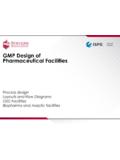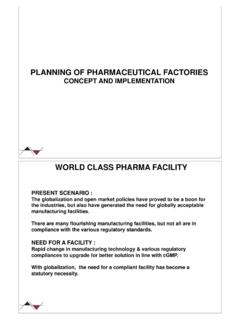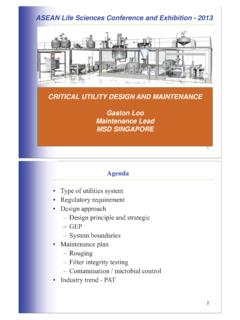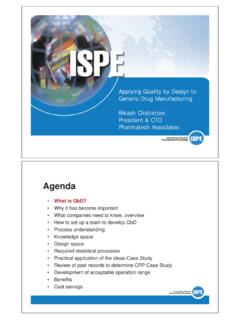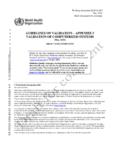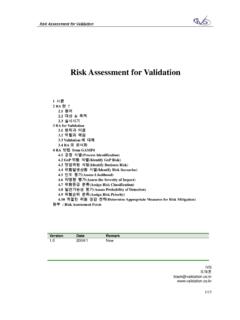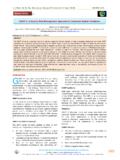Transcription of GAMP 4/5 Prospective / retrospective Qualification …
1 gamp 4/5 Prospective / retrospective Qualification of water treatment plants)P. 2 Table of 4 and gamp 5 Prospective Qualification retrospective Qualification strategy27/03/2009 Slide 31. gamp 4 and gamp 5 differences Why revision of gamp 4: To align with the concepts and terminology of recent regulatory and industry developments such as:-ICH Q 9 (Annex 20)-FDA: Pharmaceutical cGMPs for the 21st Century: A Risk based Approach Avoid duplication of activities Leverage supplier activities to the maximum possible extent, while still ensuring fitness for intended use Scale all life cycle activities and associated documentation according to risk, complexity and novelty Recognize that most computerized systems are now based on configurable packages, many of them networked27/03/2009 Slide 41.
2 gamp 4 and gamp 5 differences Drivers for gamp 527/03/2009 Slide 51. gamp 4 and gamp 5 differences Overview of the significant changes gamp 4 to gamp 5 gamp 5 now describes the whole life cycle (including: concept, project, operation, retirement) gamp 5 arranges the Quality risk management as a central element in all phases of the life cycle gamp 5 was aligned with the ASTM E2500 and the ISPE Baseline-Guide Commissioning and Qualification terminology gamp 5 now gives the suppliers a key role in the development processes and in the operation processes gamp 5 has simplified the gamp categories, Chapters of the gamp 4 which describes special types of computer systems were canceled BUT.
3 The gamp 5 remains compatible with the principles in gamp 427/03/2009 Slide 61. gamp 4 and gamp 5 differences Life Cycle The general simplified Life Cycle:27/03/2009 Slide 71. gamp 4 and gamp 5 differences Life Cycle Phases 27/03/2009 Slide 81. gamp 4 and gamp 5 differences Quality Risk Management (QMS): The QMS is a systematic approach for the assessment, control, communication and review of risks to patient safety, product quality and data integrity. It is an iterative process applied throughout the entire system life cycle. Section 5 describes this approach and how the activities should be based on good science and product and process understanding. Benefit of the risk based approach: Better knowledge about the processes and because of that a better process control (also described in ICH Q8 (QbD), ICH Q9 (QMS), ICH Q10 (PQS)) Safeguard patient safety, product quality, and data integrity, while also delivering business benefit A central element to reducing the validation effort by concentrating on the most critical processes and therewith reducing the validation costs27/03/2009 Slide 91.
4 gamp 4 and gamp 5 differences Aligned terminology The classical nomenclature of IQ, OQ and PQ are not longer used in gamp 5 Implementation of the word verification instead of the classical nomenclature Focusing of the contents of the created documents not longer of the nomenclature. But also the classical nomenclature can be used Unification of the following Guidelines:-FDA: Pharmaceutical cGMPs for the 21st Century: A Risk based Approach-ASTM E2500- gamp 5-ISPE Baseline-Guide Commissioning and Qualification 27/03/2009 Slide 101. gamp 4 and gamp 5 differences Key role of the suppliers Ensuring compliance and fitness for purpose is the responsibility of the regulated company The supplier gets more liberties, but also more responsibilities The supplier gets the liberty to carry out the system development in accordance of accepted development- and quality management methods ( ISO 9000) without consideration of specific GxP requirements Documentation of the suppliers can be taken directly and without changing the format in the validation documentation of the regulated company (no duplication)
5 Services of the suppliers should be overtaken considerable as possible (in specification and verification processes) 27/03/2009 Slide 111. gamp 4 and gamp 5 differences Confrontation gamp 4 and gamp 5 referring to the suppliers role Appendix O 2 Establishing and Managing Support ServiceAppendix O 2 Example Procedure for the Production of a Service Level AgreementAppendix M 6 Supplier Quality and Project PlanningAppendix M 2 Supplier AssessmentAppendix M 2 Guideline for Supplier AuditChapter supplier participationChapter 8 Management System for Suppliers of IT SystemsChapter good practice activitiesChapter 7 Supplier activitiesChapter Assessment and EducationGAMP 5 gamp 427/03/2009 Slide 121.
6 gamp 4 and gamp 5 differences gamp 5 Main Body Structure Key Concepts Life Cycle Approach Life Cycle Phases Concept Project Operation Retirement Science Based Quality Risk Management Regulated Company Activities Governance for Achieving Compliance System Specific Activities Supplier Activities Efficiency Improvements 27/03/2009 Slide 131. gamp 4 and gamp 5 differences Main Changes of the gamp 5 appendices27/03/2009 Slide 141. gamp 4 and gamp 5 differences Main Changes of the gamp 5 appendices27/03/2009 Slide 151. gamp 4 and gamp 5 differences Main Changes of the gamp 5 appendices27/03/2009 Slide 161. gamp 4 and gamp 5 differences gamp Software CategoriesCustom software (supplier assessments rather than auditsCustom software5 Configured software (supplier assessments rather than audits)Configurable software packages4 Non-configured softwareStandard software3No longer used (Firmware is no longer functionally distinguishable)Firmware2 Ifrastructure softwareOperating system1 gamp 5 gamp 4 Category27/03/2009 Slide 171.)
7 gamp 4 and gamp 5 differences Size of verification software category 327/03/2009 Slide 181. gamp 4 and gamp 5 differences Size of verification software category 427/03/2009 Slide 191. gamp 4 and gamp 5 differences Size of verification software category 527/03/2009 Slide 201. gamp 4 and gamp 5 differences Movements and Benefits Reduction of validation costs (as a result of the risk based approach and a stronger comprehension of the suppliers activities) A better process acknowledgement (on side of the regulated company and on side of the suppliers) More flexibility of improvements (simplification of the validation process)27/03/2009 Slide 212. CHRIST Prospective Qualification strategy V-ModelURSR equirements of the UserFDSA ffirmation of the Requirements of the supplierTechnical SpecificationsManufacturing of the EquipmentPQOQIQ27/03/2009 Slide 222.
8 CHRIST Prospective Qualification strategy The CHRIST Qualification Conception The validation shall show that the water treatment system is installed correctly according to the design specification and that the system works correctly. The validation is divided in two sections: FAT Factory Acceptance Test SAT Site Acceptance Test In each section (FAT and SAT), both installation inspections (IQ) and functional inspections (OQ) are carried out. In order to reduce the time needed for on-site Qualification , as many inspections and tests as possible are executed during the FAT, before the system leaves the factory. CHRIST has a special test bed and can, in most cases, also carry out test runs of the system before it is 232.
9 CHRIST Prospective Qualification strategy DQ-Documents: Order Confirmation (FDS) (or optional customized FDS) Risk analysis (FMEA iterative) Quality and project plan (QPP) (optional) Technical Specifications P&ID List of Components Hardware Specifications Circuit Diagram Hardware Design Specification (HDS) Software Specifications Functional Logic (FL) Software Design Specification (SDS) 27/03/2009 Slide 242. CHRIST Prospective Qualification strategy Example P&ID27/03/2009 Slide 252. CHRIST Prospective Qualification strategy Example of Risk analyses (iterative)27/03/2009 Slide 262. CHRIST Prospective Qualification strategy IQ Tests during FAT 1. Inspection of the Mechanical Installation and the Documentation P&ID:Check that the water treatment system is built according to the P&ID Component list:Check that all components of the system are in accordance with the list of components Manuals and Data Sheets:Check manuals and data sheets from the sub-supplier Certificates for components:Check the certificates (which are specified in the list of components) for all components Dead-Legs:Check that no dead-legs are present on the product side (3d or 6d rule) Air gap to drain:Check by visual inspection that the pipe to drain leaves an air gap to the drainage.
10 Welding documentation:Check that the welding documentation for the water treatment system (including certificates for pipes and fittings) is present and 272. CHRIST Prospective Qualification strategy IQ Tests during FAT 2. Inspection of the Electrical Hardware (Hardware Acceptance Test) Inspection of the switchgear cabinet:Check that the inspection record sheet for the switchgear cabinet is completely filled out and that the document is signed and dated. Line test:Check that the line test inspection sheet (external cables, digital inputs and outputs, analogue inputs and outputs) is completely filled out and that the document is signed and dated. Main switch:Check the consequence of power failure (simulation through the main switch)27/03/2009 Slide 282.
